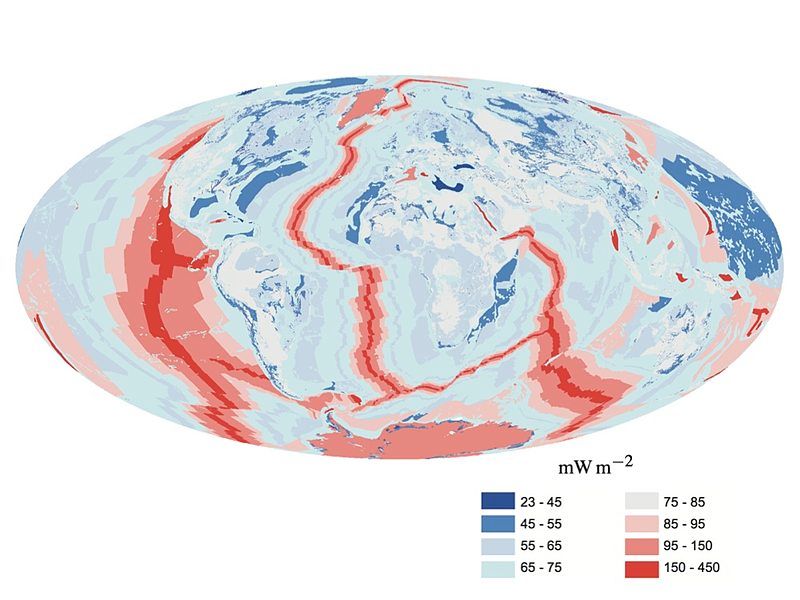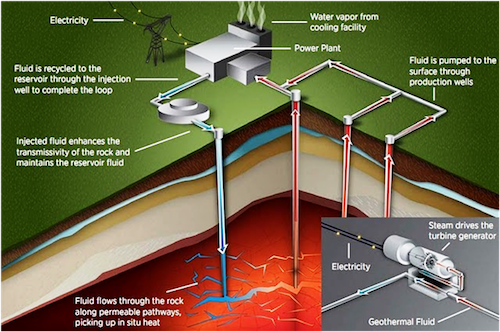Deep Geothermal Energy
At the last evening meeting ( March 17th via Zoom) Dr. Ian Stimpson ( Keele University) gave a very informative talk on deep geothermal energy. The aim of the talk was to help us understand the concepts of geothermal energy and how it could apply to the UK as it has the possibility to become a very green and low carbon source of energy.
Geothermal energy ( i.e. heat derived from the ground) can be divided into two main categories shallow and deep. Dr Stimpson concentrated the talk on the aspect of deep geothermal as our next talk in April ( to be given by Ashley Patton) will be of shallow geothermal.
The difference between the two is related to depth. Shallow geothermal heat is stored near the surface and is derived from external to earth sources or solar radiation with the earth acting as a solar battery. In contrast deep geothermal sources are at greater depth with the energy arising from mechanisms internal to the earth from primordial heat from when the earth was formed and radioactive decay of long-lived isotopes of uranium, thorium and potassium.
There are advantages to using geothermal as firstly, it is not affected by the weather and can therefore run for 24 hours per day. Secondly, the surface area of the plant is the smallest of any power source and as the buildings are not high there is little visual impact. It has been predicted that it could provide up to 20% of Uk’s energy needs.
But where are the best places for geothermal energy projects. This can be determined by observing the heat flow through the crust. It has been found that large areas of the crust have about the same heat flow with an average of 60mW m-2. The areas in the world where heat flow is much greater are found close to active plate margins below the ocean. Values on the continents can be as high as 300 mW m-2 where magma is being generated locally.

Global Heat Flow- wiki commons Davies and Davies
For a geothermal system there are 3 requirements: heat, water and permeability. So one means of obtaining the energy is to drill down into the natural ground water in a deep aquifer. Two wells are bored one for abstracting the hot water and the other for returning the cold water to the ground. But often permeability or water may be a problem so that new enhanced geothermal systems ( EDS) have been or are being developed.

Geothermal Energy Tapping - wiki Commons Energy.gov
One EDS is the hot dry rock system (HDR). The target rock being granite as it is rich in uranium, thorium and potassium. This requires the rock to be artificially fractured. Cold water is pumped down the injection well to produce a network of tiny fractures in the rock which creates a pathway through the rock along which water can flow. Water is heated up and the super-heated water is taken back to the surface via another well. Although it is a difficult method it is one that can be used in areas, for example the UK, away from active plate margins where the highest energies are present. There was an early research project into HDR system at Rosemanowes Quarry Cornwall during the 1980s. Data and knowledge gained from this project have been used for the new United Downs Deep Geothermal Project (UDDGP) in Cornwall. This project, instead of fracking the granite, will use naturally fractured rock around the Porthtowan Fault zone.
A further idea for obtaining energy is to use super critical CO2 to release the energy.Known as ECO2G the idea is that CO2 can be cycled through hot regions kilometres underground and would bring heat to the surface, where it can be used to generate electricity.
Further, there are a new generation of closed loop systems known as advanced geothermal systems (AGS). This idea moves on from using fracking and there are no fluids either put into the ground or extracted. Instead fluids circulate underground in a network of sealed pipes, pick up the heat and take it to the surface. One of these systems is planned by Eavor, a Canadian company. It’s system has two vertical wells 1.5 miles apart and connected by horizontal wells. In this system fluid is pumped down a borehole and is transferred along a series of horizontal boreholes, picks up the heat energy which is then utilised. The now cooled fluid is then pumped back down along another series of boreholes in the opposite direction.
Within the UK geothermal energy appears to be playing catch-up compared to
other parts of the world. The idea was investigated during the 1970’s but with North Sea gas and nuclear energy becoming cheaply available geothermal was
abandoned. With the climate crisis ever deepening green energy solutions are
urgently required.
In the UK we do not have volcanic sources of energy but do have deep saline
aquifers. These are permeable, porous rocks mainly found at depth in the
Mesozoic basins ( Permo-Triassic sandstones) For example the Cheshire basin
where the resources are concentrated in the south east of the basin against the main bounding fault at Crewe.
The first geothermal power plant based on a deep saline aquifer was in
Southhampton in 1981 utilising the rocks in the Wessex Basin. It still produces energy today.
The Uk also has areas of granite in south west England, the Lake District and
Scotland that could be suitable for HDR and the first one in Cornwall is due to be opened.